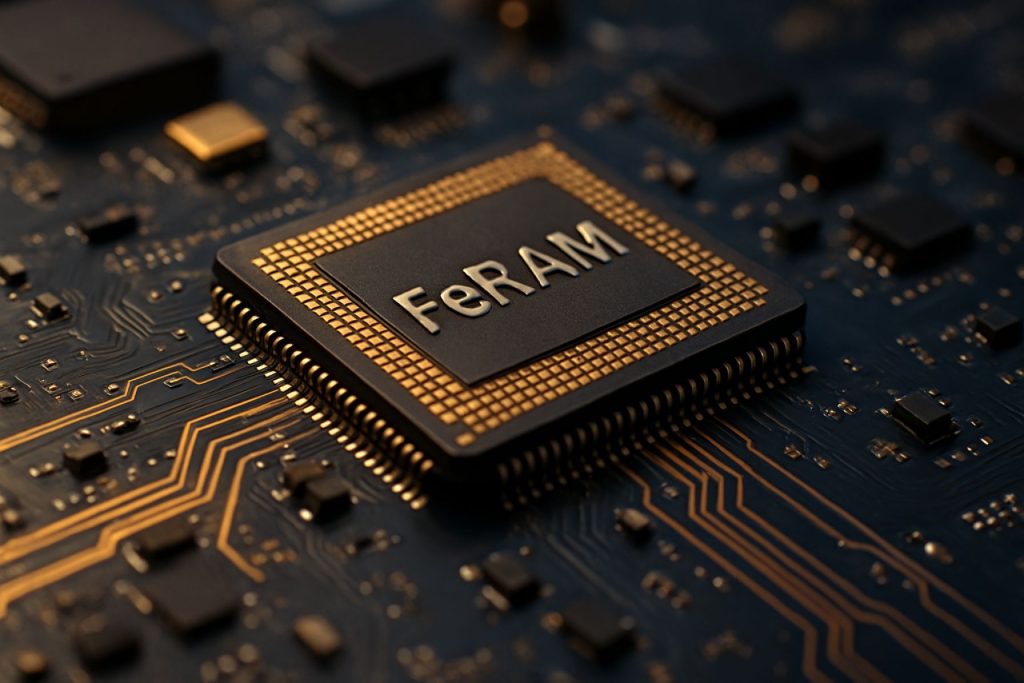
Ferroelectric Memory Device Engineering in 2025: Unleashing Next-Gen Performance and Market Expansion. Explore How Innovations Are Shaping the Future of Non-Volatile Memory Technology.
- Executive Summary: Ferroelectric Memory Devices in 2025
- Market Size, Growth, and Forecasts (2025–2029)
- Key Technology Innovations and Engineering Advances
- Competitive Landscape: Leading Companies and New Entrants
- Application Trends: Consumer Electronics, Automotive, and IoT
- Materials Science: Advances in Ferroelectric Thin Films and Integration
- Manufacturing Challenges and Solutions
- Regulatory, Standards, and Industry Initiatives (e.g., ieee.org)
- Investment, M&A, and Strategic Partnerships
- Future Outlook: Opportunities, Risks, and Disruptive Scenarios
- Sources & References
Executive Summary: Ferroelectric Memory Devices in 2025
Ferroelectric memory device engineering is poised for significant advancements in 2025, driven by the convergence of material innovation, process integration, and the urgent demand for energy-efficient, high-speed non-volatile memory. Ferroelectric Random Access Memory (FeRAM) and emerging ferroelectric field-effect transistor (FeFET) technologies are at the forefront, offering low-power operation, fast switching speeds, and high endurance—characteristics increasingly critical for next-generation computing, automotive, and edge AI applications.
In 2025, leading semiconductor manufacturers are accelerating the commercialization of ferroelectric memory. Texas Instruments continues to supply FeRAM products for industrial and automotive sectors, leveraging the technology’s inherent radiation hardness and low power consumption. Meanwhile, Samsung Electronics and Taiwan Semiconductor Manufacturing Company (TSMC) are investing in the integration of ferroelectric hafnium oxide (HfO2)-based materials into advanced logic and memory nodes, aiming to enable embedded non-volatile memory (eNVM) for system-on-chip (SoC) solutions.
The engineering focus in 2025 is on scaling ferroelectric layers to sub-10 nm nodes, improving endurance beyond 1012 cycles, and ensuring compatibility with standard CMOS processes. Infineon Technologies and GlobalFoundries are collaborating with research institutes to optimize deposition techniques and interface engineering, addressing challenges such as wake-up effects and retention loss. The adoption of HfO2-based ferroelectrics, compatible with existing high-k metal gate processes, is a key enabler for mass production and cost-effective scaling.
In parallel, startups and research spin-offs are entering the market with novel device architectures. Ferroelectric Memory GmbH (FMC) is licensing its FeFET IP to foundries, targeting ultra-low-power AI accelerators and IoT devices. The company’s technology roadmap includes multi-level cell (MLC) operation and sub-20 nm integration, with pilot production expected to ramp up in the next few years.
Looking ahead, the outlook for ferroelectric memory device engineering is robust. Industry roadmaps anticipate the first commercial deployment of embedded FeRAM and FeFET in advanced nodes (5 nm and below) by 2026–2027, with further improvements in density, speed, and reliability. As the ecosystem matures, collaboration between material suppliers, foundries, and system integrators will be crucial to overcoming remaining technical barriers and unlocking the full potential of ferroelectric memory in mainstream electronics.
Market Size, Growth, and Forecasts (2025–2029)
The ferroelectric memory device market is poised for significant growth between 2025 and 2029, driven by escalating demand for non-volatile, low-power, and high-speed memory solutions in applications ranging from embedded systems to artificial intelligence and automotive electronics. Ferroelectric memory technologies—primarily Ferroelectric Random Access Memory (FeRAM) and emerging Ferroelectric Field-Effect Transistor (FeFET) memories—are gaining traction as alternatives to conventional flash and DRAM, particularly as scaling challenges and energy efficiency become critical in next-generation electronics.
As of 2025, the global market for ferroelectric memory devices is estimated to be in the low hundreds of millions of US dollars, with projections indicating a compound annual growth rate (CAGR) exceeding 20% through 2029. This robust expansion is underpinned by the increasing integration of ferroelectric memories in microcontrollers, smart cards, and IoT devices, where their fast write speeds, high endurance, and low power consumption offer distinct advantages over traditional memory technologies.
Key industry players are actively scaling up production and advancing technology nodes. Infineon Technologies AG remains a leading supplier of FeRAM, targeting industrial, automotive, and security applications. The company’s focus on reliability and endurance has positioned its ferroelectric memory products as a preferred choice for mission-critical systems. Ferroxcube and Texas Instruments Incorporated are also notable contributors, with Texas Instruments offering a range of FeRAM products for embedded and low-power applications.
On the technology development front, Samsung Electronics and Taiwan Semiconductor Manufacturing Company (TSMC) are investing in the integration of ferroelectric materials into advanced logic and memory nodes, exploring FeFET and ferroelectric HfO2-based devices for future system-on-chip (SoC) and AI accelerators. These efforts are expected to yield commercial products within the forecast period, further expanding the addressable market.
Geographically, Asia-Pacific is anticipated to dominate market share, propelled by the region’s robust semiconductor manufacturing ecosystem and aggressive adoption of next-generation memory in consumer electronics and automotive sectors. North America and Europe are also expected to see steady growth, particularly in industrial automation and secure identification applications.
Looking ahead to 2029, the ferroelectric memory device market is expected to benefit from continued miniaturization, improved endurance, and the emergence of new application domains such as edge AI and neuromorphic computing. Strategic partnerships between material suppliers, foundries, and device manufacturers will be crucial in overcoming technical barriers and accelerating commercialization, ensuring that ferroelectric memory technologies play a pivotal role in the evolving memory landscape.
Key Technology Innovations and Engineering Advances
Ferroelectric memory device engineering is experiencing a period of rapid innovation, driven by the need for high-speed, low-power, and scalable non-volatile memory solutions. In 2025, the focus is on advancing ferroelectric random-access memory (FeRAM), ferroelectric field-effect transistors (FeFETs), and related device architectures, leveraging new materials and process integration techniques.
A major breakthrough in recent years has been the adoption of doped hafnium oxide (HfO2)-based ferroelectric thin films, which are compatible with standard CMOS processes and scalable to sub-10 nm nodes. This has enabled leading semiconductor manufacturers to prototype and, in some cases, begin pilot production of FeFET and FeRAM devices with improved endurance, retention, and switching speed. Infineon Technologies AG and Samsung Electronics are among the companies actively developing and demonstrating hafnium oxide-based ferroelectric memory, with Samsung reporting successful integration of FeFETs into advanced logic platforms.
Device engineering efforts are also focused on 3D integration and vertical stacking, which promise higher density and lower cost per bit. In 2025, research and early commercial efforts are exploring 3D FeRAM arrays and vertical FeFETs, with the goal of matching or exceeding the density of established non-volatile memories such as NAND flash. Taiwan Semiconductor Manufacturing Company (TSMC) and GlobalFoundries are both investing in process development for ferroelectric memory integration at advanced nodes, aiming to offer embedded non-volatile memory (eNVM) options for AI, IoT, and automotive applications.
Another key innovation is the engineering of interface layers and electrodes to enhance ferroelectric properties and device reliability. Companies are optimizing stack designs to minimize depolarization fields and leakage currents, with Texas Instruments and Renesas Electronics Corporation both reporting progress in FeRAM endurance and data retention through materials and process improvements.
Looking ahead, the outlook for ferroelectric memory device engineering is promising. The next few years are expected to see the first commercial deployments of embedded FeFET and FeRAM in microcontrollers and edge AI chips, as well as continued scaling toward 5 nm and below. Industry roadmaps suggest that ferroelectric memories could become a mainstream eNVM solution, offering a compelling combination of speed, endurance, and low power for emerging applications.
Competitive Landscape: Leading Companies and New Entrants
The competitive landscape of ferroelectric memory device engineering in 2025 is characterized by a dynamic interplay between established semiconductor giants and innovative new entrants, all vying to commercialize next-generation non-volatile memory technologies. Ferroelectric memory, particularly ferroelectric random-access memory (FeRAM) and ferroelectric field-effect transistors (FeFETs), is gaining traction due to its potential for high speed, low power consumption, and scalability compatible with advanced CMOS processes.
Among the established leaders, Texas Instruments (TI) remains a prominent supplier of FeRAM products, leveraging decades of experience in embedded non-volatile memory for industrial and automotive applications. TI’s FeRAM portfolio is recognized for its endurance and reliability, and the company continues to invest in process improvements to enhance density and reduce costs.
In the foundry and memory manufacturing space, Samsung Electronics and Taiwan Semiconductor Manufacturing Company (TSMC) are actively exploring ferroelectric memory integration. Samsung, a global leader in DRAM and NAND, has announced research initiatives into hafnium oxide-based FeFETs, aiming to address the scaling limitations of conventional flash memory. TSMC, the world’s largest pure-play foundry, is collaborating with materials suppliers and research institutes to evaluate ferroelectric materials for embedded memory in advanced logic nodes.
European players are also making significant strides. Infineon Technologies has a legacy in FeRAM and continues to support industrial and automotive customers, while GlobalFoundries is developing embedded ferroelectric memory solutions for IoT and edge computing applications.
On the new entrant front, startups and university spin-offs are accelerating innovation. Ferroelectric Memory GmbH (FMC), a German startup, is commercializing hafnium oxide-based FeFET technology, which is compatible with standard CMOS processes and promises high density and low power operation. FMC has secured partnerships with major foundries and is piloting embedded FeFET memory for AI and automotive applications. Other notable entrants include Novachips, which is exploring FeRAM for high-performance storage, and several stealth-mode startups in the US and Asia focusing on novel ferroelectric materials and device architectures.
Looking ahead, the competitive landscape is expected to intensify as demand for energy-efficient, high-endurance memory grows in AI, automotive, and edge computing markets. Strategic collaborations between material suppliers, foundries, and system integrators will be crucial for scaling ferroelectric memory technologies to mass production. The next few years will likely see further consolidation, with leading players seeking to acquire or partner with innovative startups to accelerate commercialization and secure intellectual property in this rapidly evolving field.
Application Trends: Consumer Electronics, Automotive, and IoT
Ferroelectric memory device engineering is rapidly advancing, with significant implications for consumer electronics, automotive systems, and the Internet of Things (IoT) as of 2025 and looking ahead. Ferroelectric RAM (FeRAM) and emerging ferroelectric field-effect transistor (FeFET) technologies are being positioned as alternatives to conventional non-volatile memories, such as flash, due to their low power consumption, high endurance, and fast switching speeds.
In consumer electronics, the demand for energy-efficient and high-performance memory is driving the adoption of ferroelectric memory. Major semiconductor manufacturers, including Texas Instruments and Fujitsu, have been at the forefront of FeRAM commercialization, with products already integrated into smart cards, wearables, and industrial devices. As of 2025, these companies are expanding their FeRAM portfolios to address the growing need for instant-on functionality and data retention in battery-powered devices. The integration of FeRAM into microcontrollers is expected to accelerate, enabling faster boot times and improved reliability in smartphones, tablets, and other portable electronics.
The automotive sector is another key area where ferroelectric memory devices are gaining traction. The shift toward electric vehicles (EVs) and advanced driver-assistance systems (ADAS) requires robust, high-endurance memory capable of withstanding harsh environments. Infineon Technologies and Renesas Electronics are actively developing FeRAM solutions tailored for automotive applications, focusing on data logging, event recording, and secure storage for critical system parameters. The non-volatility and radiation resistance of ferroelectric memories make them particularly suitable for automotive safety and reliability requirements, and their adoption is projected to increase as vehicles become more connected and autonomous.
In the IoT domain, the proliferation of edge devices and sensors is fueling demand for ultra-low-power, high-endurance memory. Ferroelectric memory’s ability to perform frequent write operations without degradation is a key advantage for IoT nodes that require constant data logging and real-time analytics. Companies such as Texas Instruments and Fujitsu are supplying FeRAM components for smart meters, industrial automation, and medical devices, where reliability and data integrity are paramount. Looking forward, the integration of FeFET-based non-volatile memory into advanced CMOS processes is anticipated to further reduce power consumption and enable new classes of intelligent, always-on IoT devices.
Overall, the next few years are expected to see continued innovation and broader deployment of ferroelectric memory devices across these sectors, driven by the need for faster, more reliable, and energy-efficient memory solutions.
Materials Science: Advances in Ferroelectric Thin Films and Integration
The field of ferroelectric memory device engineering is experiencing rapid advancements, particularly in the development and integration of ferroelectric thin films. As of 2025, the focus has shifted toward scalable, CMOS-compatible materials and processes that enable high-density, low-power, and high-endurance non-volatile memories. Hafnium oxide (HfO2)-based ferroelectric thin films have emerged as the leading candidate for next-generation ferroelectric random-access memory (FeRAM) and ferroelectric field-effect transistors (FeFETs), due to their compatibility with existing semiconductor manufacturing and their robust ferroelectric properties at nanometer thicknesses.
Major semiconductor manufacturers are actively pursuing the commercialization of HfO2-based ferroelectric devices. Samsung Electronics and Taiwan Semiconductor Manufacturing Company (TSMC) have both reported progress in integrating ferroelectric HfO2 into advanced logic and memory nodes, with pilot production lines expected to scale up in the next few years. Infineon Technologies continues to supply FeRAM products based on traditional perovskite materials, but is also investing in HfO2 research for future nodes. Meanwhile, GlobalFoundries has announced collaborations with academic and industrial partners to accelerate the adoption of ferroelectric memories in embedded applications.
Recent breakthroughs in atomic layer deposition (ALD) and chemical solution deposition (CSD) techniques have enabled the fabrication of ultra-thin, uniform ferroelectric films with precise control over dopant concentration and crystallinity. These advances are critical for achieving reliable switching behavior and endurance exceeding 1010 cycles, a key requirement for commercial memory applications. The integration of ferroelectric films with silicon substrates, as well as the development of new electrode materials to minimize leakage and fatigue, are active areas of research and development.
Looking ahead, the next few years are expected to see the first large-scale deployment of HfO2-based FeRAM and FeFETs in both standalone and embedded memory markets. Industry roadmaps indicate that ferroelectric memories will play a crucial role in enabling energy-efficient artificial intelligence (AI) accelerators, edge computing devices, and secure microcontrollers. The continued collaboration between leading foundries, materials suppliers, and equipment manufacturers will be essential to overcoming remaining challenges in scalability, reliability, and cost-effectiveness, paving the way for widespread adoption of ferroelectric memory technologies by the late 2020s.
Manufacturing Challenges and Solutions
Ferroelectric memory device engineering is at a pivotal juncture in 2025, as manufacturers strive to overcome persistent challenges in scaling, integration, and reliability. The transition from traditional ferroelectric materials such as lead zirconate titanate (PZT) to hafnium oxide (HfO2)-based ferroelectrics has enabled compatibility with advanced CMOS processes, but has also introduced new complexities in deposition, patterning, and defect control. Leading semiconductor foundries and memory manufacturers, including Samsung Electronics, Taiwan Semiconductor Manufacturing Company (TSMC), and Infineon Technologies, are actively investing in process optimization to address these hurdles.
One of the foremost manufacturing challenges is achieving uniform, ultra-thin ferroelectric films with consistent polarization properties across large wafers. Atomic layer deposition (ALD) has emerged as the preferred technique for HfO2-based ferroelectrics, but controlling dopant distribution and minimizing oxygen vacancies remain critical for device endurance and retention. Equipment suppliers such as Lam Research and Applied Materials are developing next-generation ALD and etch tools tailored for ferroelectric memory integration, focusing on atomic-level precision and defect mitigation.
Integration with logic and embedded systems presents another layer of complexity. As ferroelectric random-access memory (FeRAM) and ferroelectric field-effect transistors (FeFETs) are increasingly considered for embedded non-volatile memory in automotive and IoT applications, process compatibility with advanced nodes (e.g., 28nm and below) is essential. GlobalFoundries and Tower Semiconductor have announced pilot lines and partnerships to bring embedded ferroelectric memory to market, emphasizing co-optimization of ferroelectric layers with backend-of-line (BEOL) processes.
Reliability and scalability are ongoing concerns. Ferroelectric fatigue, imprint, and retention loss must be minimized for commercial viability. In 2025, collaborative efforts between device manufacturers and materials suppliers, such as Merck KGaA (a major supplier of high-purity precursors), are focused on refining material purity and interface engineering to extend device lifetimes.
Looking ahead, the outlook for ferroelectric memory device manufacturing is cautiously optimistic. Industry roadmaps suggest that by 2027, scalable FeRAM and FeFET solutions could achieve parity with established non-volatile memories in select applications, provided that current challenges in uniformity, integration, and reliability are addressed through continued innovation and cross-industry collaboration.
Regulatory, Standards, and Industry Initiatives (e.g., ieee.org)
The regulatory landscape and standardization efforts for ferroelectric memory device engineering are rapidly evolving as the technology matures and approaches broader commercialization. In 2025, the focus is on harmonizing device performance, reliability, and interoperability standards to facilitate integration into mainstream semiconductor manufacturing and end-user applications.
The IEEE continues to play a pivotal role in setting technical standards for emerging memory technologies, including ferroelectric random-access memory (FeRAM) and ferroelectric field-effect transistors (FeFETs). The IEEE Standards Association is actively developing and updating standards that address device characterization, endurance, retention, and interface protocols, ensuring that ferroelectric memories can be reliably benchmarked against established non-volatile memory (NVM) technologies. These efforts are crucial for enabling cross-vendor compatibility and supporting the adoption of ferroelectric memories in automotive, industrial, and consumer electronics sectors.
Industry consortia such as the JEDEC Solid State Technology Association are also instrumental in defining specifications for memory modules and interfaces. In 2025, JEDEC is expected to release updated guidelines for non-volatile memory devices, including those based on ferroelectric materials, focusing on aspects such as data retention, write endurance, and power consumption. These guidelines are being developed in close collaboration with leading semiconductor manufacturers and memory suppliers, ensuring that the unique properties of ferroelectric devices—such as low-voltage operation and fast switching—are adequately addressed.
On the regulatory front, compliance with international environmental and safety directives remains a priority. Ferroelectric memory devices, often utilizing lead zirconate titanate (PZT) or hafnium oxide (HfO2)-based materials, must adhere to the European Union’s European Commission RoHS (Restriction of Hazardous Substances) and REACH (Registration, Evaluation, Authorisation and Restriction of Chemicals) regulations. Manufacturers are increasingly investing in lead-free ferroelectric materials and process innovations to ensure compliance and minimize environmental impact.
Major industry players such as Infineon Technologies AG, Texas Instruments Incorporated, and Samsung Electronics Co., Ltd. are actively participating in standards development and regulatory discussions. These companies are not only contributing technical expertise but also piloting new device architectures and manufacturing processes that align with evolving standards. Their involvement is expected to accelerate the path to mass production and market adoption of ferroelectric memory devices.
Looking ahead, the next few years will likely see increased collaboration between industry, academia, and regulatory bodies to address emerging challenges such as device scaling, reliability at advanced nodes, and integration with logic circuits. The establishment of robust standards and regulatory frameworks will be essential for unlocking the full potential of ferroelectric memory technologies in the global semiconductor ecosystem.
Investment, M&A, and Strategic Partnerships
The ferroelectric memory device engineering sector is experiencing a surge in investment, mergers and acquisitions (M&A), and strategic partnerships as the industry seeks to capitalize on the unique properties of ferroelectric materials for next-generation non-volatile memory. In 2025, this momentum is driven by the growing demand for energy-efficient, high-speed, and scalable memory solutions in applications ranging from artificial intelligence to edge computing and automotive electronics.
Major semiconductor manufacturers are at the forefront of this activity. Infineon Technologies AG, a leader in ferroelectric RAM (FeRAM), continues to invest in expanding its product portfolio and manufacturing capabilities, targeting industrial and automotive markets where data integrity and endurance are critical. Similarly, Texas Instruments Incorporated remains a key player, leveraging its expertise in embedded FeRAM for microcontrollers and analog devices.
Strategic partnerships are shaping the competitive landscape. In recent years, Samsung Electronics Co., Ltd. has intensified its collaboration with research institutes and material suppliers to accelerate the commercialization of ferroelectric field-effect transistor (FeFET) memory, aiming to integrate these devices into advanced logic and memory chips. GLOBALFOUNDRIES Inc. has also announced joint development agreements with materials companies to optimize ferroelectric hafnium oxide processes for embedded non-volatile memory, targeting the automotive and IoT sectors.
M&A activity is expected to increase as established memory manufacturers seek to acquire startups with proprietary ferroelectric material technologies or novel device architectures. For example, Micron Technology, Inc. and STMicroelectronics N.V. have both signaled interest in expanding their non-volatile memory portfolios, with industry observers anticipating potential acquisitions or technology licensing deals in the near term.
Venture capital investment is also flowing into early-stage companies developing scalable ferroelectric memory solutions. Startups focusing on hafnium oxide-based FeFETs and 3D ferroelectric memory architectures are attracting funding rounds, as investors bet on the technology’s potential to disrupt the mainstream memory hierarchy.
Looking ahead, the next few years are likely to see further consolidation and cross-industry alliances, as automotive, industrial, and consumer electronics OEMs seek secure supply chains and differentiated memory technologies. The convergence of material science innovation, process integration, and strategic investment is expected to accelerate the commercialization of ferroelectric memory devices, positioning the sector for robust growth through 2025 and beyond.
Future Outlook: Opportunities, Risks, and Disruptive Scenarios
The future outlook for ferroelectric memory device engineering in 2025 and the coming years is shaped by a convergence of technological opportunities, emerging risks, and the potential for disruptive innovation. Ferroelectric memory, particularly ferroelectric random-access memory (FeRAM) and ferroelectric field-effect transistors (FeFETs), is gaining renewed attention as the semiconductor industry seeks alternatives to conventional non-volatile memories such as flash and DRAM.
Opportunities are being driven by the unique properties of ferroelectric materials, including low power consumption, high endurance, and fast switching speeds. These characteristics are increasingly attractive for applications in edge computing, artificial intelligence (AI), and the Internet of Things (IoT), where energy efficiency and rapid data access are critical. In 2024, Texas Instruments continued to expand its FeRAM product lines, targeting industrial and automotive sectors that demand robust, radiation-resistant memory solutions. Meanwhile, Infineon Technologies has highlighted the integration of FeRAM in secure microcontrollers for payment and identification systems, leveraging the technology’s reliability and data retention capabilities.
A major disruptive scenario is the commercialization of hafnium oxide (HfO2)-based ferroelectric memories, which are compatible with standard CMOS processes. This compatibility could enable large-scale adoption and cost-effective manufacturing, challenging the dominance of established memory technologies. Samsung Electronics and GlobalFoundries have both announced research and pilot production of HfO2-based FeFETs, with expectations of scaling to advanced nodes in the next few years. The integration of ferroelectric memory into logic chips could also facilitate in-memory computing architectures, reducing data transfer bottlenecks and improving AI inference efficiency.
However, several risks remain. Material stability, device variability, and retention at nanoscale dimensions are ongoing engineering challenges. The supply chain for high-purity ferroelectric materials is still maturing, and intellectual property disputes could slow commercialization. Additionally, as the industry moves toward sub-10 nm nodes, maintaining ferroelectric properties without degradation is a significant hurdle.
Looking ahead, the next few years are likely to see increased collaboration between memory manufacturers, foundries, and equipment suppliers to address these challenges. Standardization efforts by industry bodies such as Semiconductor Industry Association will be crucial for ecosystem development. If technical and supply chain risks are managed, ferroelectric memory devices could become a disruptive force in the memory landscape by the late 2020s, enabling new classes of energy-efficient, high-performance electronics.
Sources & References
- Texas Instruments
- Infineon Technologies
- Ferroelectric Memory GmbH
- Ferroxcube
- Fujitsu
- IEEE
- JEDEC Solid State Technology Association
- European Commission
- Micron Technology, Inc.
- STMicroelectronics N.V.
- Semiconductor Industry Association



